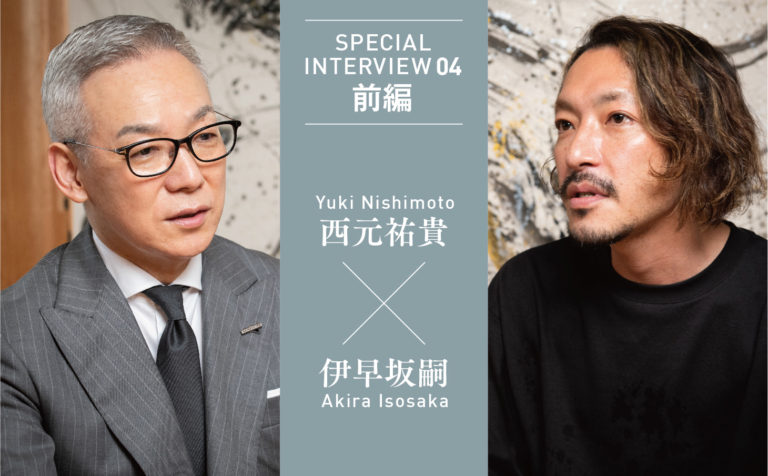
CEO Blog-SPECIAL INTERVIEW 04 Part 1 -Common Points of Creation and Manufacturing. Factors for realizing “Tradition and Innovation”
-
- Category:
- COLUMN
-
- Date:
- Nov.11.2022
In order for Kawashima to become a company that pursues high-quality value, the fourth guest of the interview and the fourth guest to learn from leading people in various fields is Mr. Yuki Nishimoto, a ink painting artist.
Mr. Yuki Nishimoto, who is appreciated around the world sublimated the traditional art style of “”Sumie”” into contemporary art. We asked him about his dedication to creative work and the source of his motivation, as well as about his work as a professional.”
We were able to obtain suggestions on both the common aspects of the Kawashima’s manufacturing and the points to be learned.
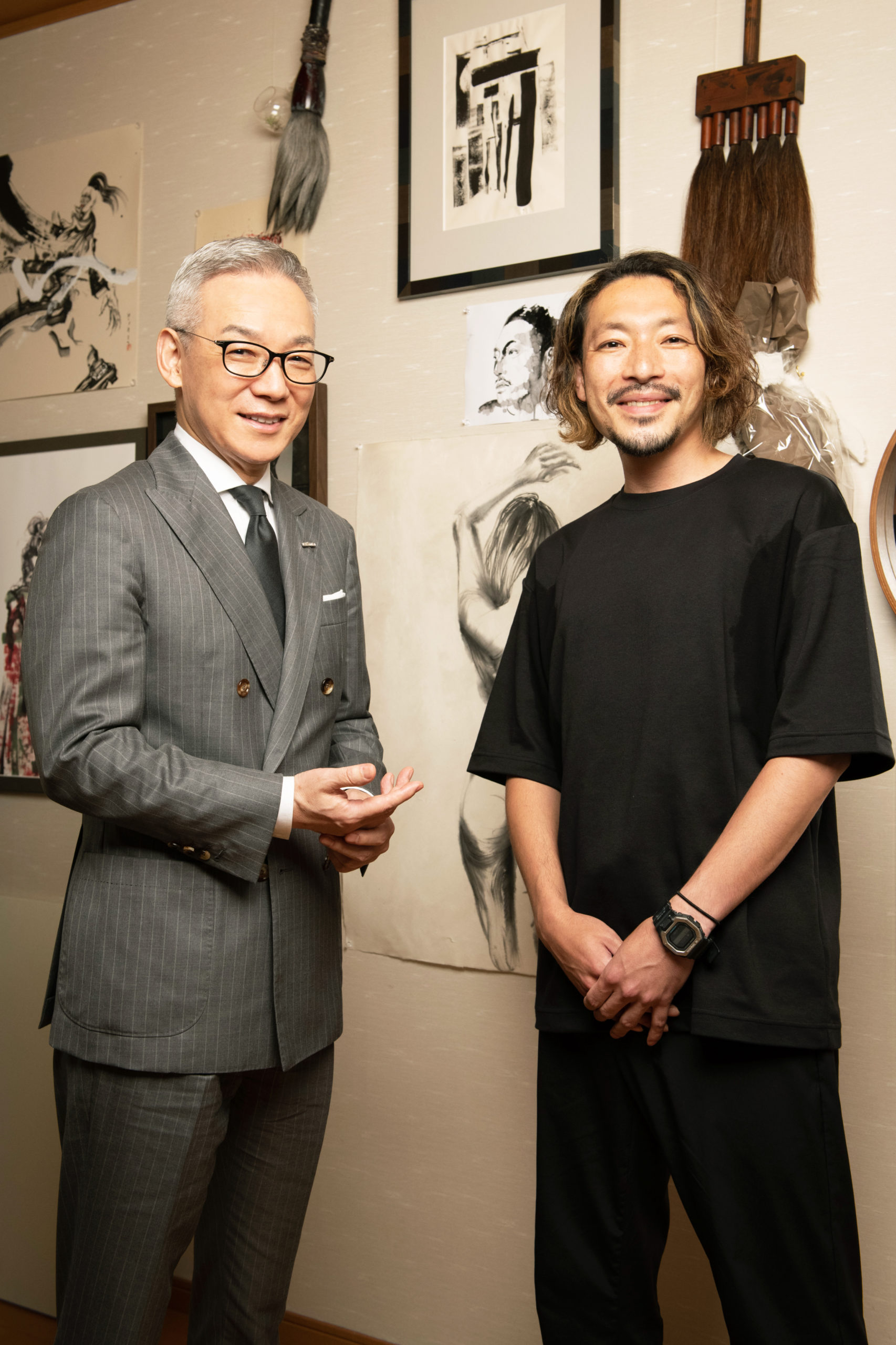
“Subtraction aesthetics” common to packaging machinery and ink painting
Mr. Isosaka: When I saw Mr. Nishimoto’s work for the first time on a TV show, I was hoping to hear more about his aesthetic sense, how Mr. Nishimoto sublimated his ink painting into contemporary art, and his theory of professionalism.It is my honor to see you in this way.
Mr. Nishimoto: Thank you.I read your book, “Beyond Expectations.” I also have something to ask Mr. Isosaka, so please allow me to ask you a question.
Mr. Isosaka: Have you read the book? Thank you very much.Once again, briefly explaining us, in 111 years since our founding as a packaging machine manufacturer, I have taken over our representatives for six years.Although the efforts and pioneering spirits of our predecessors are now present, we want to not only simply take over the history and technologies, but also make changes and innovations toward the next 100 years.
In fact, Mr. Nishimoto has added value to the traditional painting technique called ink painting and has opened up a new world.I want to learn what we can take from your efforts and thoughts.
Mr. Nishimoto: Thank you.Rather than trying to pioneer a new genre of ink painting, the original motivation behind the creation was to create a picture of the dynamism of athletes.I experienced oil painting, watercolor painting, and pencil painting. The ink painting was the most capable of expressing the “dynamic feeling.”
I was also particular about the feeling of a live performance like an athlete, and I started to feel attracted to the world of one-shot fighting which cannot be redrawn.
If you say I’ve opened up a new world, maybe it’s the result of pursuing what I want to express.Nevertheless, I am still in the process of development.
Mr. Isosaka: Even when I see the live painting, it is drawn in one shot, and it is only the expression of “white” of paper and “black” of ink, so ink painting is a world that is not deceptive, isn’t it? In the spirit of manufacturing, we have the aesthetics of subtraction. After unnecessary products are removed, the product is not deceptive. We want to continue to make products that are particular about this essence.I also wanted to ask if there is anything in common with this “subtraction aesthetics.”
Mr. Nishimoto: I wanted to ask the very same question.”In sumi-e, “”subtraction”” is “”margin””.”
Compose your pictures with a focus on a place that is not drawn rather than the place you draw.I sketch repeatedly until composing the picture, then I draw with empty mind.The feeling of placing a brush rather than drawing it at that time.I am conscious of the rhythm very much.
Mr. Isosaka: I see.Looking at Mr. Nishimoto’s art, I felt that you were very conscious of the distribution of white and black, the balance between light and shadow, and so on.Even in the case of a dragon ink painting, it isn’t painted in detail, is it?
Mr. Nishimoto: No, it isn’t.More technically speaking, it also creates the illusion of the viewer’s eyes by drawing light and shadows in a discrete manner for each angle and part.Therefore, various interpretations are generated depending on the person who sees the same picture.Some people think that the dragon’s whiskers also have black part, while others feel that way in the white part.
“At one exhibition, some people said, “”That red piece was good,”” even though it was in two colors, black and white, and I think that person felt the red power from the painting.”
Mr. Isosaka: The margin will stir your imagination, isn’t it?
Mr. Nishimoto: This is exactly what I intend to do.I leave interpretations and evaluations to the viewers.
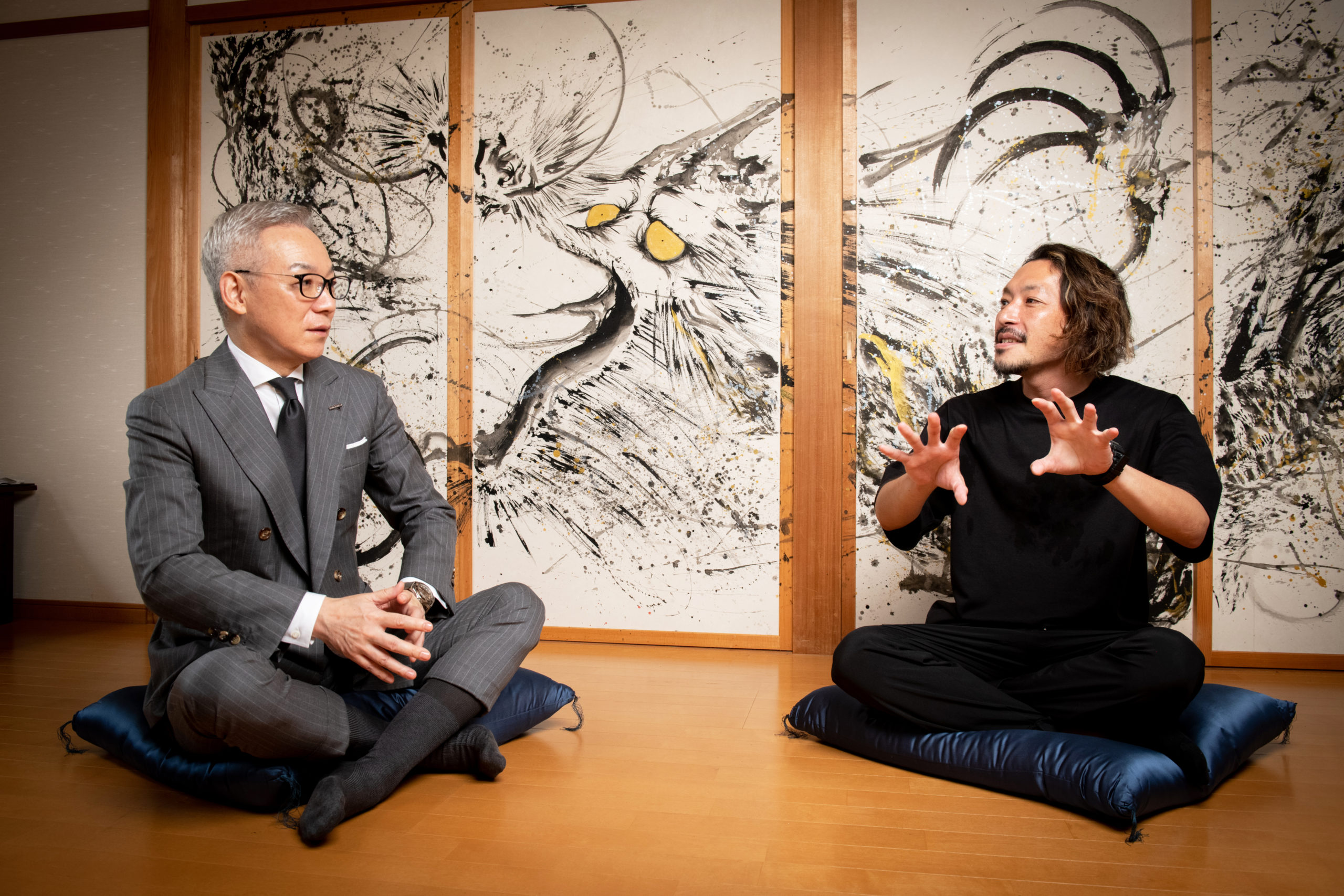
Daily attention and preparation lead to the ideal creation
Mr. Isosaka : You said that you are preparing a lot before you put in your brush, but do you have any customs or routines that you usually try?
Mr. Nishimoto: I travel back and forth between Fukuoka, where I live, and Fukui, where the studio is located. Each city where the solo exhibition is held, but I have no brushes except in the studio.Sketching is repeated by Ipad at home, at a cafe, and at a destination, etc. to formulate the concept.After taking a lot of preparation, I hold the brush and face the Japanese paper finally.Concentration only lasts about 2 hours.
Mr. Isosaka: When you paint live, the performance is about 10 or 20 minutes, but it seems that you will also use a considerable amount of energy at this time, isn’t it?
Mr. Nishimoto: That’s right.If I concentrate on 15 minutes in show, it is enough.Creation needs a physical strength, so I regularly go to a gym, and I eat one meal a day.It is more concentrated when I feel hungry.
Mr. Isosaka: you are strict with yourself, aren’t you?There is an aesthetic sense from everyday life, and frankly speaking, it’s “cool.”I always tell my employees to live coolly as a person and to do cool work, and that it will be a cool company.
It sounds very simple to hear only cool words, but it requires constant daily effort, and it is difficult to act as it is, because of its simplicity.I also feel the aesthetics of subtraction from Mr. Nishimoto’s way of life.
Mr. Nishimoto: I have more friends with athletes and musicians than my peers, but all of them are all self-disciplined and inspired by them.When it comes to creation, if the body is distorted, the work is distorted as well.That’s why I take care of my everyday life.
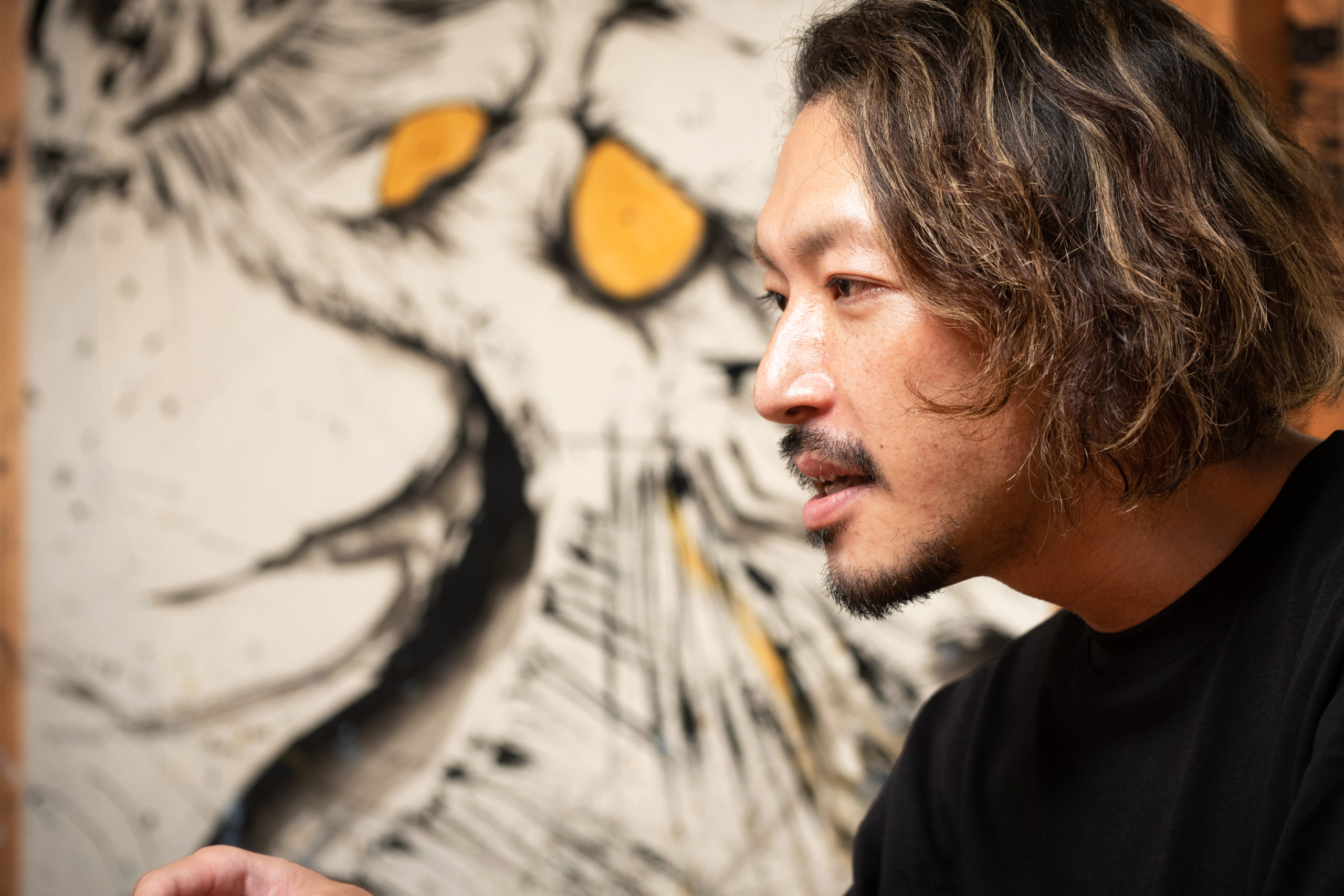
There is no border between professionals and amateurs.Everything is told by the work
Mr. Isosaka: Mr. Nishimoto’s iconic art, “dragon”, has been a request from a soba restaurant in Fukuoka, hasn’t it?
Mr. Nishimoto: In 2011 aiming to become a professional, in order to get many people to see the my painting, I made a live painting with a paper and board in a park. This was the opportunity.This was my first time drawing by receiving a request, and this was my first time drawing with money, and this led to an increase in work requests.
Mr. Isosaka: What do you think about being professional?
Mr. Nishimoto: When I started drawing, I felt like to be admitted to a lot of people, but after 30, I had lost those feelings.
Now there are no professionals or amateurs, and I think that my works are everything.It’s all about trying to express what you felt and thought.
I don’t think it’s just about self-satisfaction, but it’s about someone else’s sake.In the first place, if only I could live on the earth, would I paint a picture?…… I imagine that the ancients would like to convey something, so they would have painted scarlet letters and pictures on the wall.
Mr. Isosaka: The motivation underlying the creation is not only for the desire to express oneself, but also for the benefit of those around you, such as having someone happy or impressed you, isn’t it? This feeling is the same as our manufacturing.
Mr. Nishimoto: Today, I paint ink on a three-meter piece of Japanese paper with a pure white hand. At first, a craftsman of Echizen washi told me, “Washi is not pure white in nature, and cannot make such a large piece of washi.” Nevertheless, when I somehow draw pictures, the craftsmen were very happy, the range of expressions expanded.
Mr.Isosaka: This story adds new value to the tradition that must be protected.We must add new value to our packaging machinery and -packaging culture.
Perhaps that is born when each person, like Mr. Nishimoto, is particular about it and enthusiasm, isn’t it?I was very stimulated.I still have a lot to ask.Thank you for your time.
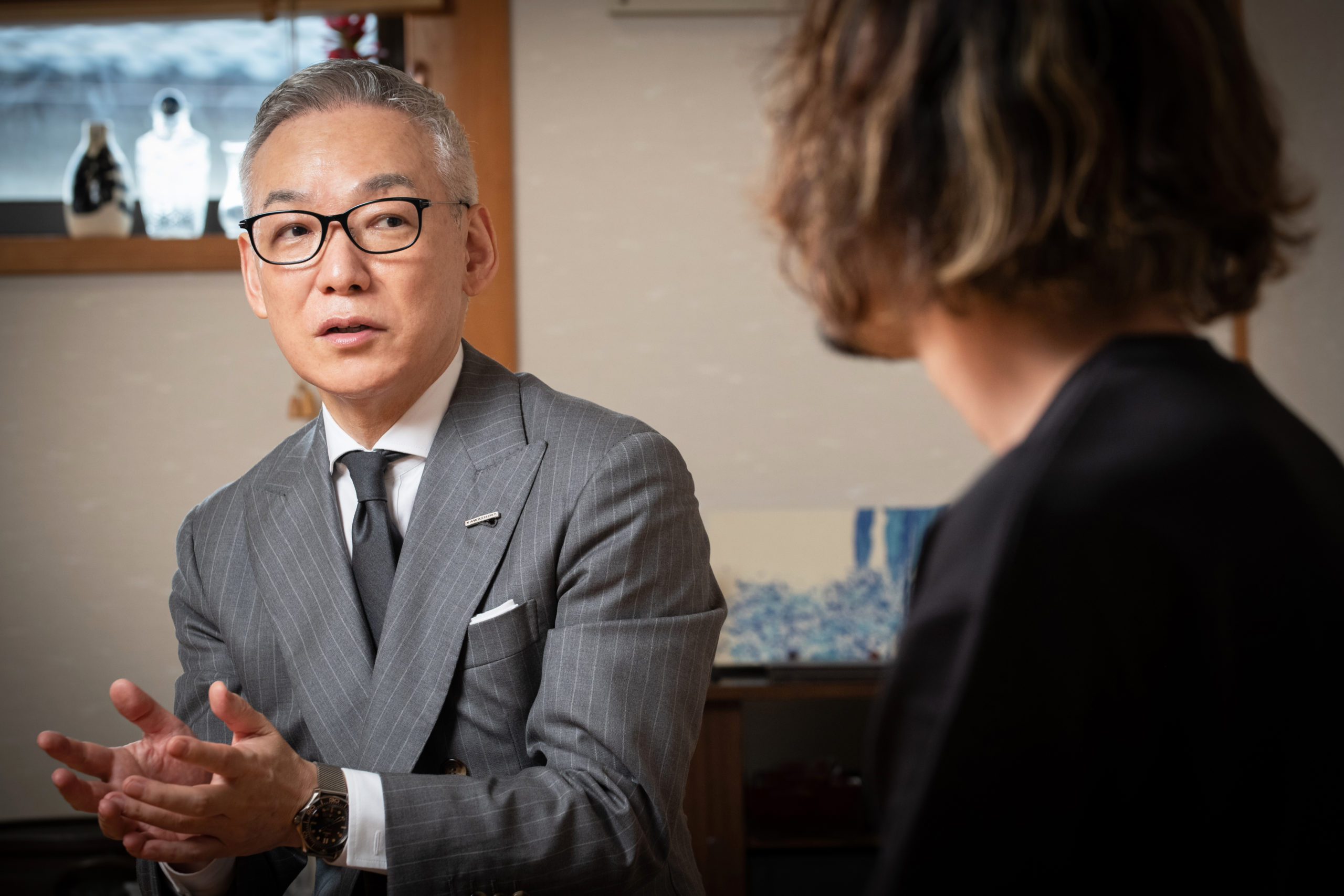
[Continued from the latter part]
In the later edition, we discuss the important topics of creativity and manufacturing, “observational skills,” “importance of continuation,” and “the future of packaging.”
Nishimoto Yuki
He was born in Kagoshima Prefecture in 1988.Japan’s leading ink painting and ceramic ink painting artist attracting worldwide attention.Developed a work that is not captured by traditional techniques but pursues “dynamic” and “powerful” with a touch that is bold and delicate.From classical motifs such as dragons and samurai, novel motifs such as athletes and musicians are also drawn.
“Live Paint” is often shown on events and TV programs, and the painting of his art, just after drawing was awarded at Hong Kong dollar 85,000 (about ¥1.3 million) in the Christies auction in Hong Kong.The appearance of the impressive ink painting at the moment of its appearance attracts and overwhelms the viewers around the world.
In 2015, a new modern art “Ceramic painting” by Mr.Nishimoto was released.The technique of ink painting which has energitic touch and the nature which does not fade in a thousand years by drawing with glaze on the plate of pottery and baking at high temperature are integrated. It gave great admitted by the various fans and collectors.
In February 2016, Nishimoto Yuki Ceramic Gallery, the first in Japan, was opened in Fukui Prefecture, which is the base for production.Many fans visit this gallery as a wall painting down the wall and a gallery where they can experience works by VR.
In addition, the 2020 exhibition “Destroying and Creation,” which also challenged new techniques that could be achieved by ceramic boards, saw a significant increase in artistic possibilities, with most of the works being bought by buyers, while the impact of the new corona limited the number of visitors to the exhibit.
In addition, he is playing on global stages in activities that do not fit in any type, such as individual exhibitions and live performances overseas in Europe, the United States, and China, as well as collaboration with CG and moving images, and various other fields.
Official site
https://www.yuki-nishimoto.com/
Shooting/Takahiro Yamada
Sentence/cross-media marketing




